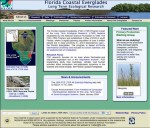Over the past year, the FCE LTER information management system (IMS) team members, Linda Powell and Mike Rugge, redesigned and enhanced the FCE website (http://fcelter.fiu.edu/) to better provide the general public and scientific community with the information and tools that are important to each audience.
The team unveiled the redesigned website to the public in January 2008. Information in the site is now organized under a series of 'Tabs' and sub-headings that facilitate navigation, and many of the topical choices are represented by graphical icons to draw the audience into the website. The IMS team partnered with a science writer, Sara LaJeunesse, to translate the FCE research introduction and results into a format that is readily understood by general audiences.
The biggest changes to the website can be found under the 'About Us' tab, where we added features that cater to the general public's interest. The section provides an overview of FCE activities and details of the Florida Everglades, such as its history and culture, nature and science, and issues and restoration. Here, visitors can undertake a variety of activities, such as launching a slide show of Dr. Mike Heithaus' Bull Shark tagging field research in the Everglades.
The FCE LTER program is currently organized into five working groups and three cross-cutting themes. The 'Working Group' sub-section under 'FCE Research' blends general and scientific information (under an 'Introduction' written for the public), and abstracts, hypotheses, and findings written for the scientific community. Each working group's introduction explains how the working group's research affects people in South Florida. Users will also find details and links for all personnel, projects, datasets, and publications related to the particular working group.
For the scientific community, the website has many important features, such as a searchable project information, research site locations, personnel, sampling, datasets, and publications that are relationally linked to each project. Many sections have been simplified and made more researcher friendly. For example, the FCE Data section (http://fcelter.fiu.edu/data/) has a series of graphical icons that represent different data types and sources. Upon selecting a data type, the user is taken directly to a data source, such as the FCE core datasets, or given a link to an outside data source such as the EcoTrends Project Socioeconomic Catalog. Additionally, the FCE core data can now be searched by themes or using an advanced search process that includes a spatial search component.
Future website features are expected to include providing a general public section in Spanish and adding a comprehensive section on Everglades modeling to feature model results and provide a user interface for researchers to run model scenarios through the FCE website.
Visit the FCE website
Linda Powell is FCE's Information Manager

 Enlarge this image
Enlarge this image